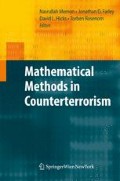Abstract
There is now intense interest in the problem of forecasting what a group will do in the future. Past work [1, 2, 3] has built complex models of a group’s behavior and used this to predict what the group might do in the future. However, almost all past work assumes that the group will not change its past behavior. Whether the group is a group of investors, or a political party, or a terror group, there is much interest in when and how the group will change its behavior. In this paper, we develop an architecture and algorithms called CAPE to forecast the conditions under which a group will change its behavior. We have tested CAPE on social science data about the behaviors of seven terrorist groups and show that CAPE is highly accurate in its predictions—at least in this limited setting.
Access this chapter
Tax calculation will be finalised at checkout
Purchases are for personal use only
Preview
Unable to display preview. Download preview PDF.
References
Martinez, V., Simari, G.I., Sliva, A., Subrahmanian, V.S.: Convex: Similarity-based algorithms for forecasting group behavior. IEEE Intelligent Systems 23(4) (2008) 51–57
Subrahmanian, V.S., Albanese, M., Martinez, V., Nau, D., Reforgiato, D., Simari, G.I., Sliva, A., Wilkenfeld, J.: Cara: A cultural adversarial reasoning architecture. IEEE Intelligent Systems 22(2) (2007) 12–16
Subrahmanian, V.S.: Cultural modeling in real-time. Science 317(5844) (2007) 1509–1510
Schrodt, P.: Forecasting conflict in the balkans using hidden markov models. In: Proc. American Political Science Association meetings. (2000)
Bond, J., Petroff, V., O’Brien, S., Bond, D.: Forecasting turmoil in indonesia: An application of hidden markov models. In: International Studies Association Convention, Montreal. (2004) 17–21
Martinez, V., Simari, G.I., Sliva, A., Subrahmanian, V.S.: The SOMA terror organization portal (STOP): Social network and analytic tools for the real-time analysis of terror groups. In Liu, H., Salerno, J., Young, M., eds.: Social Computing, Behavioral Modeling and Prediction, Spring Verlag (2008) 9–18
Khuller, S., Martinez, V., Nau, D., Simari, G.I., Sliva, A., Subrahmanian, V.S.: Finding most probable worlds of probabilistic logic programs. In: Proc. 2007 International Conference on Scalable Uncertainty Management. Volume 4772., Springer Verlag Lecture Notes in Computer Science (2007) 45–59
Khuller, S., Martinez, V., Nau, D., Simari, G., Sliva, A., Subrahmanian, V.S.: Computing most probable worlds of action probabilistic logic programs: Scalable estimation for 1030,000 worlds. Annals of Mathematics and Artificial Intelligence 51(2-4) (2007) 295–331
Wilkenfeld, J., Asal, V., Johnson, C., Pate, A., Michael, M.: The use of violence by ethnopolitical organizations in the middle east. Technical report, National Consortium for the Study of Terrorism and Responses to Terrorism (2007)
Bowerman, B., O’Connell, R., Koehler, A.: Forecasting, Time Series and Regression. Southwestern College Publ (2004)
Ullman, J.: Principles of Database and Knowledge Base Systems. Volume 2. Computer Science Press, Maryland (1989)
Author information
Authors and Affiliations
Corresponding author
Editor information
Editors and Affiliations
Rights and permissions
Copyright information
© 2009 Springer-Verlag/Wien
About this chapter
Cite this chapter
Sliva, A., Subrahmanian, V., Martinez, V., Simari, G. (2009). CAPE: Automatically Predicting Changes in Group Behavior. In: Memon, N., David Farley, J., Hicks, D.L., Rosenorn, T. (eds) Mathematical Methods in Counterterrorism. Springer, Vienna. https://doi.org/10.1007/978-3-211-09442-6_15
Download citation
DOI: https://doi.org/10.1007/978-3-211-09442-6_15
Publisher Name: Springer, Vienna
Print ISBN: 978-3-211-09441-9
Online ISBN: 978-3-211-09442-6
eBook Packages: Computer ScienceComputer Science (R0)

